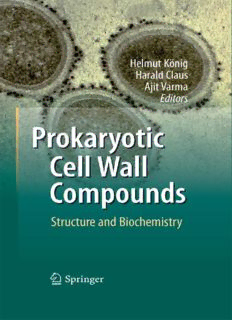
Prokaryotic Cell Wall Compounds: Structure and Biochemistry PDF
Preview Prokaryotic Cell Wall Compounds: Structure and Biochemistry
Prokaryotic Cell Wall Compounds Helmut Ko¨nig Harald Claus Ajit Varma l l Editors Prokaryotic Cell Wall Compounds Structure and Biochemistry Editors Prof.Dr.HelmutKo¨nig Dr.HaraldClaus InstituteofMicrobiologyandWine InstituteofMicrobiologyandWine Research Research JohannesGutenberg-University JohannesGutenberg-University Becherweg15 Becherweg15 55099Mainz,Germany 55099Mainz,Germany [email protected] [email protected] Prof.Dr.AjitVarma DirectorGeneral AmityInstituteofMicrobial Technology AmityUniversityUttarPradesh &ViceChairman AmityScience,Technology &InnovationFoundation BlockA,AmityCampus Sector125 Noida,UP201303,India [email protected] ISBN978-3-642-05061-9 e-ISBN978-3-642-05062-6 DOI10.1007/978-3-642-05062-6 SpringerHeidelbergDordrechtLondonNewYork LibraryofCongressControlNumber:2010922367 #Springer-VerlagBerlinHeidelberg2010 Thisworkissubjecttocopyright.Allrightsarereserved,whetherthewholeorpartofthematerialis concerned,specificallytherightsoftranslation,reprinting,reuseofillustrations,recitation,broadcasting, reproductiononmicrofilmorinanyotherway,andstorageindatabanks.Duplicationofthispublication orpartsthereofispermittedonlyundertheprovisionsoftheGermanCopyrightLawofSeptember9, 1965,initscurrentversion,andpermissionforusemustalwaysbeobtainedfromSpringer.Violations areliabletoprosecutionundertheGermanCopyrightLaw. Theuseofgeneraldescriptivenames,registerednames,trademarks,etc.inthispublicationdoesnotimply, evenintheabsenceofaspecificstatement,thatsuchnamesareexemptfromtherelevantprotectivelaws andregulationsandthereforefreeforgeneraluse. Coverdesign:WMXDesignGmbH,Heidelberg,Germany Printedonacid-freepaper SpringerispartofSpringerScience+BusinessMedia(www.springer.com) Terrypassedawayshortlyafterwritingtheforeword.ThedeathofTerryisnotonly a great loss for his family but also for his colleagues and the microbiological community.Weofferourcondolencesandretainhiminmemory. Foreword Prokaryote cells are uncomplicated cells possessing a simple design. All prokar- yotes, whether they are archaea or bacteria, rely on their surfaces for multiple functions, including being a barrier with their external environment; most do this viaacellenvelopeofwhichthemostimportantstructureisthecellwall.Thereare two fundamental structural varieties of walls, that is, the Gram-positive or Gram- negativeformats,andmanybacteriaalsopossessassociatedstructurallayersontop of the wall, for example, capsules, sheaths, or S-layers. Since prokaryotes are the most diverse and ubiquitous life forms on Earth, involved in almost all natural cycles, including elemental cycling and many forms of disease, their surfaces are therequiredprimaryinterfacebetweenthecellanditssurroundings,oftenmediat- ingor catalyzing important interactions. This book provides an up-to-date knowl- edge of the prokaryotic cell wall, including its structure, composition, synthesis, assembly,andsomesurfaceinteractions. Becauseoftheimportanceofcellwalls,manyresearchershavespenttheirwhole lives attempting to enlighten the scientific community about a single aspect of a bacterial surface. One such researcher is U.B. Sleytr of the Center for NanoBio- technology,BOKU–UniversityofNaturalResourcesandAppliedLifeSciencesin Vienna, Austria. Throughout his career, Uwe has had one central focus; to deter- minethestructureandfunctionofbacterialS-layers.HebeganhisS-layerstudiesin themid-1960s,workingprimarilyonBacillusstearothermophilus(nowGeobacil- lus), B. sphaericus, and several thermophilic clostridia. During this time, he con- centrated on the detection and high-resolution structure of their constituent S (surface)-layers using transmission electron microscopy, quickly becoming a highlyrespectedmicroscopistwhoexcelledinthecryo-techniqueoffreeze-etching. In his hands, S-layers provided breathtaking images since they are composed of regulararraysofratherlargeMW(glyco)proteinsthatcouldbereadilyviewedby electron microscopy. Linear (p2), tetragonal (p4), and hexagonal (p3 and p6) latticeswerediscovered,whichprovedtobebuiltthroughself-assemblyprocesses. Uwe wasquicktorecognizethatS-layersprovided anatural nano-scale construc- tion of regularly arranged proteins (and holes) that, under the correct conditions, vii viii Foreword couldbeassembledordisassembled.Thiswassurelyasystemthatcouldbemoulded into many applications, and under the guidance of Uwe’s deft hands, became a promisingnanobiotechnologicalplatformforawiderangeofuses(e.g.biomimetic membranes, diagnostics, biochips, supramolecular medicine, nanoglycobiology, and bioprocess technology). He now heads the Center for NanoBiotechnology in Vienna with three groups (i.e. Nanoengineered Biomaterials, Nanoglycobiology, and Molecular Biotechnology and Biomimetic Membranes) dedicated to finding applicationsforS-layers. IhaveknownUwesincetheearly1970swhenwebothworkedonS-layersand we have been friends ever since. We both remain dedicated “cell wallogists” and shareamultidisciplinaryapproachtoourscience.Uweandseveralofhisresearchers provide chapters in this book, which reflects their expertise (along with all other authors)andtheirimpactonthecellwallfield.Itisourgreatpleasuretodedicatethis booktoourgoodfriendUweSletyrontheoccasionofhis65thbirthday. { Guelph,July2007 TerryJ.Beveridge Preface For the further evolution of single-celled organisms, the development of cell wall structures was advantageous for the successful colonization of different moderate and extreme habitats. Therefore, cell wall polymers are important cell compo- nents of prokaryotic microbes. They are involved in different manifestations of life. Cell walls play a role in shape maintenance, protection against harmful agents, cell adhesion, and positive and negative biological activities against host cells. Studiessincethe1950srevealedthatquitedifferentcellwallpolymerscouldbe part of the cell wall profiles. The structure and functions of the main cell wall polymers, such as peptidoglycan (murein, pseudomurein), outer membrane pro- teins, lipopolysaccharides, teichoic acids, teichuronic acids, lipoteichoic acids, S-layer subunit and cell-wall associated proteins, have been elucidated in the last 60 years. The prokaryotes are divided into two domains, bacteria and archaea. Each of these two domains possesses its own cell wall structures. Most bacteria are char- acterized by peptidoglycan sacculi composed of murein, while this polymer is lacking in the archaea. Some archaeal methanogens could possess pseudomurein instead.ThecommoncellwallcompoundofArchaeaisasinglelayerofcrystalline proteinsubunits(S-layer)coveringthecytoplasmicmembranedirectly.S-layersare foundinbacteriaontheoutsideofthemureinsacculiofGram-positivecellsorthe outer membrane in Gram-negative organisms. In addition, pseudomurein, hetero- polysaccarides,lipoglycans,andglutaminylglucanarefoundinarchaea,leadingto apositiveGramstaining. Thisbookprovidesacomprehensiveanalysisofsomeselectedcurrenttopicson therecentadvancesmadeinthestructuresandbiochemistryofcellwallpolymers, andcaterstotheneedsofstudentsandscientistsoflivesciences. We want to thank all the authors for putting down their experiences on paper, which facilitated this comprehensive survey on the different novel aspects of microbial cell walls. Finally, we are grateful that under the responsibility of ix x Preface Dr.DieterCzeschlikandDr.JuttaLindenborn,theSpringerLifeSciencesEditorial realized thisbook onmicrobialcellwallstructures; thesestructuresare important componentsfortheinteractionsandstabilityofmicrobialcellsintheirenvironment. Mainz,June2009 HelmutKo¨nig,HaraldClaus,AjitVarma Contents PartI CellWallPolymersandStructuresofBacteria 1 TheMureinSacculus ..................................................... 3 SilkeLitzingerandChristophMayer 2 Occurrence,Structure,Chemistry,Genetics,Morphogenesis, andFunctionsofS-Layers .............................................. 53 PaulMessner,ChristinaScha¨ffer,Eva-MariaEgelseer, andUweB.Sleytr 3 BacterialPolysaccharideCapsules .................................... 111 DavidCorbett,ThomasHudson,andIanS.Roberts 4 Lipopolysaccharides .................................................... 133 AlbaSilipo,CristinaDeCastro,RosaLanzetta,Michelangelo Parrilli,andAntonioMolinaro 5 Structure,Biosynthesis,andFunctionofTeichoicAcids andRelatedCellWallGlycopolymersintheGram-positive CellEnvelope ............................................................ 155 MarenRautenberg,ThomasKohler,GuoqingXia, EmirKulauzovic,andAndreasPeschel 6 OuterMembraneProteins ............................................. 175 OliverMirus,AlexanderHahn,andEnricoSchleiff PartII CellWallPolymersandStructuresofArchaea 7 CellEnvelopesofMethanogens ........................................ 231 HaraldClausandHelmutKo¨nig xi
Description: